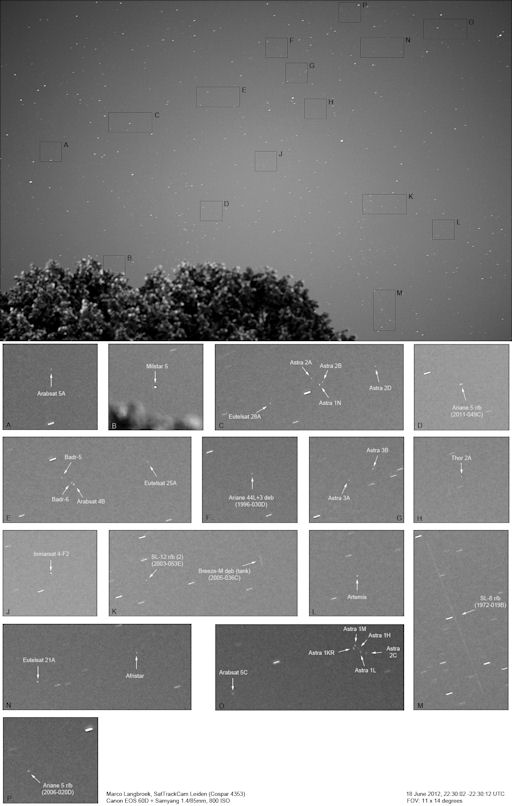FAST-GROWING SUNSPOT: Breaking the temporary monotony of a blank sun, a new sunspot is growing rapidly in near the southeastern limb of the solar disk. Readers with solar telescopes, this is your chance to observe sunspot genesis.
THE BUSY-NESS OVER YOUR HEAD: Earth orbit is crowded with nearly a thousand operating satellites and tens of thousands of spent rocket engines, splinters from satellite collisions, and other space debris. Space is a busy place. This picture taken by expert satellite watcher Marco Langbroek frames some of the madding crowd over Leiden, the Netherlands:
"This single image of a 10x14 degree-wide part of the geostationary belt was taken near midnight of June 18-19 and shows 30 satellites," says Langbroek. "Each black box contains one or more (mostly) geostationary satellites plus a few rocket bodies: 23 commercial geostationary satellites, one classified military geostationary satellite (Milstar 5), and 6 spent rocket boosters."
"The geostationary belt can be seen as a slanting line of objects diagonally over the larger image." he continues. "The geostationary belt (at declination -7.4 degrees for the Netherlands) never comes high in the sky for my country (which is at 52 N). All the objects on the picture have an elevation below 30 degrees. The image was taken from the center of Leiden--i.e. not an ideal dark sky. I did a slightly bad job in focussing, so the image is slightly less sharp (especially near the edges) than it could have been with this fine lens. Still, an amazing number of objects recorded in this small field of view!"
Realtime Space Weather Photo Gallery
![]() Near Earth Asteroids
Near Earth Asteroids![]()
Potentially Hazardous Asteroids (PHAs) are space rocks larger than approximately 100m that can come closer to Earth than 0.05 AU. None of the known PHAs is on a collision course with our planet, although astronomers are finding new ones all the time.
![]()
![]()
Recent & Upcoming Earth-asteroid encounters:
Asteroid
![]()
Notes: LD means "Lunar Distance." 1 LD = 384,401 km, the distance between Earth and the Moon. 1 LD also equals 0.00256 AU. MAG is the visual magnitude of the asteroid on the date of closest approach

![]()
Solar wind
speed: 398.2 km/sec
density: 9.5 protons/cm3
explanation | more data
Updated: Today at 1427 UT
![]()
X-ray Solar Flares
6-hr max: B3 1150 UT Jun25
24-hr: B3 1150 UT Jun25
explanation | more data
Updated: Today at: 1400 UT
![]()
![]()
![]()
Daily Sun: 25 Jun 12
![]()
![]()
A new sunspot is growing at the circled location. Credit: SDO/HMI
![]()
![]()
![]()
Sunspot number: 24
What is the sunspot number?
Updated 25 Jun 2012
Spotless Days
Current Stretch: 0 days
2012 total: 0 days (0%)
2011 total: 2 days (<1%)
2010 total: 51 days (14%)
2009 total: 260 days (71%)
Since 2004: 821 days
Typical Solar Min: 486 days
Updated 25 Jun 2012
The Radio Sun
10.7 cm flux: 85 sfu
explanation | more data
Updated 25 Jun 2012
![]()
![]()
![]()
Current Auroral Oval:
![]()
Switch to: Europe, USA, New Zealand, Antarctica
Credit: NOAA/POES
![]()
![]()
![]()
Planetary K-index
Now: Kp= 2 quiet
24-hr max: Kp= 2 quiet
explanation | more data
![]()
Interplanetary Mag. Field
Btotal: 8.8 nT
Bz: 3.1 nT south
explanation | more data
Updated: Today at 1426 UT
![]()
![]()
![]()
Coronal Holes: 24 Jun 12
![]()
![]()
An equatorial coronal hole is emerging over the eastern limb. Solar wind ETA: July 1-2. Credit: SDO/AIA.





